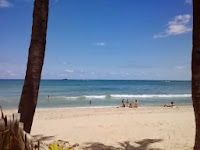 |
| WFEC studio Christened at the Lord Calvert Hotel, Overtown, Miami circa 1950 Florida State Archives |
By Jane Feehan
Miami radio station WFEC (Florida East Coast Broadcasting Company) launched operations April 10, 1949. Located at that time at 350 NE 71 Street, it promoted itself as the “Whole Family Entertainment Center.” The station, 1220 on the radio dial, featured news from the communities of Allapattah, Miami Shores, Miami Springs, Little River, 54th Street, Edison Center, North Miami and Opa-locka. Part of its early schedule included news from the Jewish community.
A day-time operation only, it shifted to “all-Negro programming”
by July 1952. By the end of that year the WFEC touted itself as “the only
station in Florida featuring all-Negro programming.” One of its disc jockeys, Carlton
King Coleman (1932-2010), became a popular Miami radio personality by the late
1950s when the station evolved into WMBM. Coleman later provided some of the
vocals for the hit song (Do the) Mashed Potatoes recorded with James Brown’s
Band. His career included his own radio shows in New York City and acting in a
few films including Bad Boys II.
The station served as an early starting point in the illustrious career of Noble V. Blackwell (1934-1994), known as "HoneyBee" to listeners. He moved on to work as director of broadcasting at WCAU-TV in Philadelphia for more than two decades and as broadcaster for NBN New York City. In 1972 Noble was honored as "Man of the Year" by the National Association of Television and Radio Announcers. He also hosted the popular TV show, Night Train in 1964. His dream of owning a radio station was realized when he bought twin staions WCDL AM and FM in Pennsylvania. He successfully transitioned them into WLSP Hit Kickin' Country.
Another WMBM personality, Larry King (1933-2021) launched
his interview show there in the late 1950s, early 1960s. He later moved to
Miami’s WIOD* and syndicated the show nationwide before landing at CNN.
Through a series of license sales, owners, radio dial
numbers, frequencies, and locations, WMBM now offers urban gospel programming
serving Miami at 1490 on the dial.
Looking back, it could be said WFEC paved the way for ethnic
programming with its rhythm and blues and gospel format for Miami’s African American
community. The station helped place the city at the vanguard of radio broadcasting
before a nationwide increase in station consolidation and decrease in
local radio identity became the norm.
For more on WIOD, see:
https://janeshistorynook.blogspot.com/2013/07/miamis-radio-610-wiod-wonderful-isle-of.html
Sources:
Miami Herald, April 10, 1949
Miami Herald, Feb. 10, 1950
Miami News, Aug. 8, 1951
Miami Herald, July 21, 1952
Miami Herald, Jan. 15, 1953
Miami Times, Nov. 30, 1957
The Tennessean, Sept. 13, 1994
Wikipedia
NB Production Team/Tracye Blackwell Johnson
Tags: Miami radio history, African American history, Miami in the 1940s, Miami in the 1950s, Miami history, Noble V Blackwell, Carlton King Coleman, Larry King




